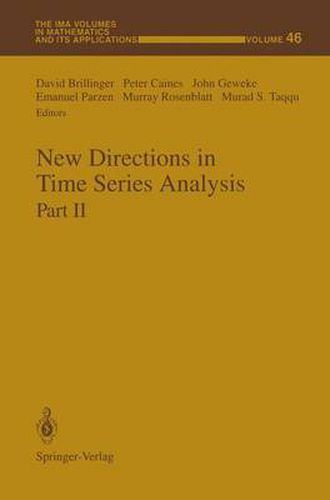Readings Newsletter
Become a Readings Member to make your shopping experience even easier.
Sign in or sign up for free!
You’re not far away from qualifying for FREE standard shipping within Australia
You’ve qualified for FREE standard shipping within Australia
The cart is loading…






This title is printed to order. This book may have been self-published. If so, we cannot guarantee the quality of the content. In the main most books will have gone through the editing process however some may not. We therefore suggest that you be aware of this before ordering this book. If in doubt check either the author or publisher’s details as we are unable to accept any returns unless they are faulty. Please contact us if you have any questions.
This IMA Volume in Mathematics and its Applications NEW DIRECTIONS IN TIME SERIES ANALYSIS, PART II is based on the proceedings of the IMA summer program New Directions in Time Series Analysis.
We are grateful to David Brillinger, Peter Caines, John Geweke, Emanuel Parzen, Murray Rosenblatt, and Murad Taqqu for organizing the program and we hope that the remarkable excitement and enthusiasm of the participants in this interdisciplinary effort are communicated to the reader. A vner Friedman Willard Miller, Jr. PREFACE Time Series Analysis is truly an interdisciplinary field because development of its theory and methods requires interaction between the diverse disciplines in which it is applied. To harness its great potential, strong interaction must be encouraged among the diverse community of statisticians and other scientists whose research involves the analysis of time series data. This was the goal of the IMA Workshop on New Directions in Time Series Analysis.
The workshop was held July 2-July 27, 1990 and was organized by a committee consisting of Emanuel Parzen (chair), David Brillinger, Murray Rosenblatt, Murad S. Taqqu, John Geweke, and Peter Caines. Constant guidance and encouragement was provided by Avner Friedman, Director of the IMA, and his very helpful and efficient staff. The workshops were organized by weeks. It may be of interest to record the themes that were announced in the IMA newsletter describing the workshop: l.
$9.00 standard shipping within Australia
FREE standard shipping within Australia for orders over $100.00
Express & International shipping calculated at checkout
This title is printed to order. This book may have been self-published. If so, we cannot guarantee the quality of the content. In the main most books will have gone through the editing process however some may not. We therefore suggest that you be aware of this before ordering this book. If in doubt check either the author or publisher’s details as we are unable to accept any returns unless they are faulty. Please contact us if you have any questions.
This IMA Volume in Mathematics and its Applications NEW DIRECTIONS IN TIME SERIES ANALYSIS, PART II is based on the proceedings of the IMA summer program New Directions in Time Series Analysis.
We are grateful to David Brillinger, Peter Caines, John Geweke, Emanuel Parzen, Murray Rosenblatt, and Murad Taqqu for organizing the program and we hope that the remarkable excitement and enthusiasm of the participants in this interdisciplinary effort are communicated to the reader. A vner Friedman Willard Miller, Jr. PREFACE Time Series Analysis is truly an interdisciplinary field because development of its theory and methods requires interaction between the diverse disciplines in which it is applied. To harness its great potential, strong interaction must be encouraged among the diverse community of statisticians and other scientists whose research involves the analysis of time series data. This was the goal of the IMA Workshop on New Directions in Time Series Analysis.
The workshop was held July 2-July 27, 1990 and was organized by a committee consisting of Emanuel Parzen (chair), David Brillinger, Murray Rosenblatt, Murad S. Taqqu, John Geweke, and Peter Caines. Constant guidance and encouragement was provided by Avner Friedman, Director of the IMA, and his very helpful and efficient staff. The workshops were organized by weeks. It may be of interest to record the themes that were announced in the IMA newsletter describing the workshop: l.